Contents
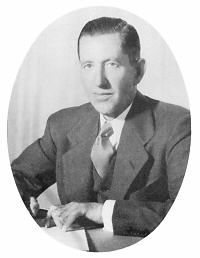
Photo: Friden Aristocrat Vol 1 No 3
Contents |

|
| Founder Carl Friden, c.1942
Photo: Friden Aristocrat Vol 1 No 3 |
Carl Friden (1891-1945) was a young Swedish engineer who arrived in the USA (via Australia) towards the end of the 1914-18 war. He found work with Marchant, and earned substantial royalties from his inventions. He sold his interests back to Marchant in around 1930, and established his own Friden Calculating Machine Company in 1933.
Friden based his new machine on the long-established uni-directional stepped-drum mechanism, with subtraction accomplished via differential reversing gears on the registers. The "Friden Roto-Flow One-way Drive", like the contemporary Swiss MADAS machine, was essentially a modern implementation of the 19th-century Thomas Arithmometer. Friden rented a factory in Oakland (California) in December 1933, and produced the first calculator to his new design in June of 1934. Rapid expansion and development led to a much-improved Model C in 1935, a new purpose-built factory in San Leandro in 1937, and a fully-automatic Model ST in 1939.
Calculator production continued during the war years, but the company also played a major role in the manufacture of precision machine tools, ordnance, and aircraft instruments. Carl Friden died in 1945 (aged only 54), but his company went on to continued successes, most notably with the Model STW fully-automatic calculator of 1949, the Model SRW square-root calculator of 1952, and the EC-130 electronic calculator of 1964.
In the late 1950s Friden acquired the Commercial Controls company and its "Flexowriter" product range. The Flexowriter was basically an up-market teleprinter consisting of an IBM electric typewriter with a paper-tape reader and punch mechanism. The company developed these machines in several directions, including a primitive word processor system, a "Computyper" billing system interfaced to an electronic calculator, and a tape-operated typesetting system. Many of the calculator instruction manuals from this period were typeset on the Friden "Justowriter". The company became the "Friden Division of Singer" in 1963, then "Singer Business Machines", but disappeared in the early 1970s as the mechanical product lines were overtaken by computer-based systems.
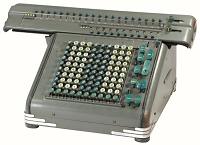 Friden Model C10, S/N 53744
Friden Model C10, S/N 53744
Technology: Stepped drum, semi-automatic.
Digits: 10 keyboard, 11 counter, 21 accumulator
Dimensions: 11"W x 13-1/2"D x 8"H, carriage width 18"
Weight: 37 pounds (16.8kg)
Manufactured: San Leandro, California, 1935 to 1949
The Model C10 was one of Friden's first machines, introduced in 1935 and continuing until replaced by the CW10 in 1950. The C10 has powered shift and clearing controls and a carriage Clear/Return key. Division is fully automatic, with a one-touch setup key and a push-button carriage tabulator. Multiplication is performed manually with the Add bar and the carriage shift keys. The case is embellished with Art Deco motifs on the four corners and on the side name plates.
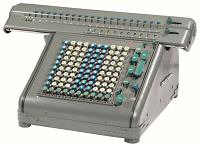 Friden Model D10, S/N 250514
Friden Model D10, S/N 250514
Technology: Stepped drum, semi-automatic.
Digits: 10 keyboard, 11 counter, 21 accumulator
Dimensions: 11"W x 13-1/2"D x 8"H, carriage width 18"
Weight: 33 pounds (14.9kg)
Manufactured: San Leandro, California, 1940 to 1949
The "General Utility Model" D10 is a simplified version of the C10 which lacks the division setup key and the automatic carriage tabulator.
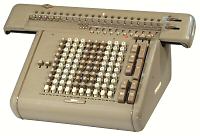 Friden Model CW10, S/N 73826A
Friden Model CW10, S/N 73826A
Technology: Stepped drum, semi-automatic.
Digits: 10 keyboard, 11 counter, 20 accumulator
Dimensions: 12"W x 14-1/2"D x 9"H, carriage width 18"
Weight: 34 pounds (15.3kg)
Manufactured: San Leandro, California, 1949-
The Friden "art-deco" machines were updated with new "streamlined" styling in 1949-50. Model CW10 is a semi-automatic machine which is functionally equivalent to the C10, except for two additional controls on the left of the keyboard which reverse or disable the counter register. The CW10 was introduced in 1949 and continued on until the end of production. The machine illustrated was built in 1954, and is still in good working order.
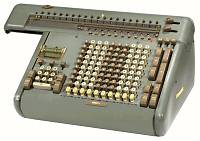 Friden Model STW10, S/N 640188A
Friden Model STW10, S/N 640188A
Technology: Stepped drum, fully automatic.
Digits: 10 keyboard, 11 counter, 20 accumulator
Dimensions: 13-1/2"W x 14-1/2"D x 8-1/2"H, carriage width 18"
Weight: 40 pounds (18.1kg)
Manufactured: San Leandro, California, 1949-
The Friden Model STW from 1949 is a re-styled version of the earlier "Super-matic Tabulator" Model ST. This is a substantial fully-automatic calculator with a separate 10-key multiplier keyboard.
To perform a multiplication, the operator enters the first factor on the main keyboard, and the second on the 10-key auxilliary keyboard on the left-hand side. Pressing "Mult" performs a normal multiplication, "Acc Mult" adds the result to the previous contents of the register, and "Neg Mult" subtracts the result from the previous value.
Special versions of the ST and STW were produced for the US Army, who wanted fully-automatic calculators that could be used where electric power was not available. This contributed photograph shows US Army surveyor R.J. Moger Jr. using a special STW in the barracks in Wiesbaden, Germany, post WWII. Note the receptacle above the name badge on the right-hand side, which allows fitting of a hand crank for manual operation. (Operators were trained to work the keyboard with the left hand, so that they could hold a pencil in the right and copy down the answers without delay). A later version of the STW (Model SRW) provided an automatic calculation of square roots.
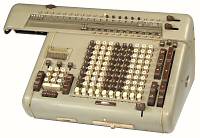 Friden Model SBT10, S/N 942164A
Friden Model SBT10, S/N 942164A
Technology: Stepped drum, fully automatic.
Digits: 10 keyboard, 11 counter, 20 accumulator
Dimensions: 14"W x 14-1/2"D x 9"H, carriage width 18"
Weight: 43 pounds (19.6kg)
Manufactured: San Leandro, California, 1959-
Model SBT is generally similar to Model STW, but with the addition of a back-transfer mechanism from the accumulator to the keyboard. The machine also has a function which allows the counter register to be used as a secondary accumulator. Sums or products in the main accumulator can be transferred positively or negatively to the counter register to provide a "Grand Total" of a series of operations. The normal counting function is temporarily disabled when the register is used in this manner.
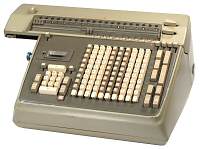 Friden Model SVE, S/N 34021JJ
Friden Model SVE, S/N 34021JJ
Technology: Stepped drum, fully automatic.
Digits: 10 keyboard, 11 counter, 20 accumulator
Dimensions: 15"W x 15-1/2"D x 9-1/2"H, carriage width 18"
Weight: 48 pounds (21.6 kg)
Manufactured: San Leandro, California, 1965-
The Model SVE was one of the last of the Friden mechanical calculators, introduced at around the same time as their first electronic machine. The SVE is generally similar to the SBT, with the addition of an automatic decimal alignment mechanism. The machine has a more angular styling, with the separate screwed panels replaced by a wrap-around skirt in cast aluminium.
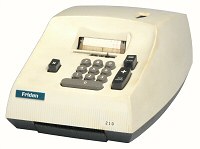 Friden Model 210, S/N F10792
Friden Model 210, S/N F10792
Electric, 10 digits
Dimensions: 9"W x 13-1/2"D x 6"H
Weight: 8-1/2 pounds
Manufactured: Friden Division of Singer, USA, late 1960s
Although labelled and sold as a Friden, this ten-key printing calculator from the late 1960s is actually a Clary Addmaster, supplied to Singer in a case designed by Marchant! More...
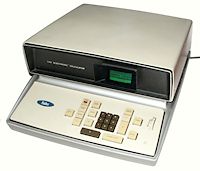 Friden Model EC-132, S/N 2811A
Friden Model EC-132, S/N 2811A
Functions: ASMD, square root, 1 memory
Technology: Discrete-component, delay line memory
Display: 13 digits, 4 registers, CRT display
Dimensions: 18-1/2"W x 22"D x 10"H, weight 43 pounds
Manufactured: Friden, USA, 1965
The Friden EC-130 from 1964 was one of the very first all-transistor electronic calculators. The circuitry was built entirely with discrete components, with internal storage provided by a mechanical delay line memory. The calculator used "reverse Polish" notation, with the four stack registers visible simultaneously on a cathode ray tube display.
This Model EC-132 from 1965 was basically identical to the EC-130, but with the addition of an automatic square root function.
The EC-132 illustrated was purchased in 1966 by the Australian
Mineral Development Laboratories, at a price in the thousands of
dollars. It was obsolete and sold for scrap within three years.
Friden EC-132 internal view (30kb)
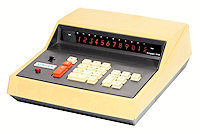 Singer/Friden Model 1115, S/N 79982A
Singer/Friden Model 1115, S/N 79982A
Functions: ASMD, constant
Technology: MOS SSI/MSI (Hitachi)
Display: 12 digits, Nixie tube
Dimensions: 240W x 330D x 110H, weight 4.66kg
Manufactured: Hitachi, Japan, 1970, for Singer Company, Friden Division.
Singer followed on from the EC130/132 machines with a range of "Friden" electronic calculators sourced from Hitachi in Japan. These machines progressed from discrete transistors with Nixie-tube displays in 1967, through MOS IC and SSI/MSI/LSI technology, to portable battery-powered calculators in 1973.
This Friden 1115 desk calculator from early 1970 is a basic 4-function machine
with a 12-digit display. It was built by Hitachi in Japan using their HD-3100
series of SSI/MSI MOS ICs and CD-79 Nixie-style display tubes. The calculator
uses a fixed decimal point, with a slider switch to select 0, 2, or 5 decimal
places in the display.
More...
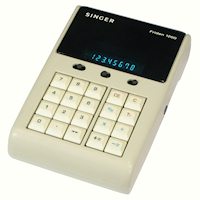 Singer/Friden Model 1200, S/N 400651
Singer/Friden Model 1200, S/N 400651
Functions: ASMD, square root, percent, constant, 1 memory
Technology: MOS-LSI (Hitachi HD3576)
Display: 8/12 digits, vacuum fluorescent tube
Dimensions: 114W x 168D x 40H, weight 0.4kg
Manufactured: Hitachi, Japan, 1973, for Singer Business Machines.
The Friden 1200 from 1973 has an 8-digit fluorescent display, but operates internally to 12 digits. A double-arrow key switches the display between the upper and lower groups of digits. The machine can be set for 0 to 7 decimal places, and includes constant, percentage, and square root functions. There is no square root key - rather, the key sequence 2 Div Equals produces the square root 1.414 (in the same way as 2 Mult Equals produced the square 4). The T key retrieves the contents of the memory register, which automatically accumulates the sum of products or quotients.
The circuitry uses a HD-3576 processor with 6 support chips. The
calculator is powered from four AA NiCad cells in a removable battery
pack, with an external mains adaptor and charger. Power consumption is
about 1200mW.
Friden 1200 circuit board (41kb)
Friden 1200 carrying case (20kb)
![]() The polished metal "Art Deco" badge from the 1930s. The Friden name
was spelt with an acute accent on the E until at least the mid-1940s.
The polished metal "Art Deco" badge from the 1930s. The Friden name
was spelt with an acute accent on the E until at least the mid-1940s.
![]() The separate plastic letters used on the back and sides of the
machines during the late 1940s and 50s.
The separate plastic letters used on the back and sides of the
machines during the late 1940s and 50s.
 The brown oval badge used on the sides of the machines in the late
1950s. The same badge with a blue background was used into the 1960s.
The brown oval badge used on the sides of the machines in the late
1950s. The same badge with a blue background was used into the 1960s.